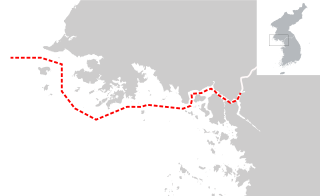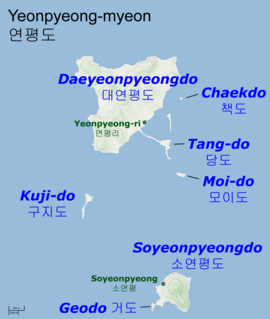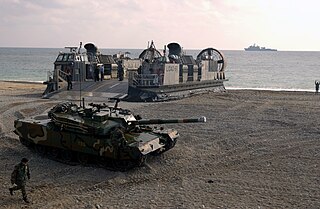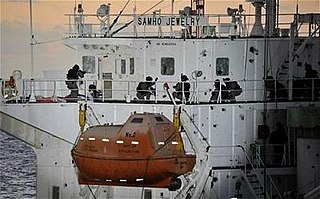
The Republic of Korea Navy, also known as the ROK Navy or South Korean navy, is the naval warfare service branch of the South Korean armed forces, responsible for naval and amphibious operations. The ROK Navy includes the Republic of Korea Marine Corps, which functions as a branch of the Navy. The ROK Navy has about 70,000 regular personnel including 29,000 Republic of Korea Marines. There are about 150 commissioned ships with the ROK Navy. The naval aviation force consists of about 70 fixed-wing and rotary-wing aircraft. The ROK Marine Corps has about 300 tracked vehicles including assault amphibious vehicles.

United States Forces Korea (USFK) is a sub-unified command of United States Indo-Pacific Command (USINDOPACOM). USFK is the joint headquarters through which U.S. combat forces would be sent to the fighting components under the South Korea/US (ROK/U.S.) Combined Forces Command (CFC) – the combined ground, air, naval, marine and special operations forces component commands. Major USFK elements include Eighth U.S. Army (EUSA), U.S. Air Forces Korea, U.S. Naval Forces in Korea (CNFK), U.S. Marine Forces Korea (MARFORK) and Special Operations Command Korea (SOCKOR). It was established on July 1, 1957.

The Northern Limit Line or North Limit Line (NLL) – 북방한계선 – is a disputed maritime demarcation line in the Yellow (West) Sea between the Democratic People's Republic of Korea (DPRK) on the north, and the Republic of Korea (ROK) on the south. This line of military control acts as the de facto maritime boundary between North and South Korea.

The Yoon Youngha-class patrol vessel also known as PKG-class patrol vessel is a class of patrol ship of the Republic of Korea Navy. One variant is in active service and a smaller variant is planned. The first being the PKX-A or Yun Youngha-class missile patrol ship, and the second the PKX-B class patrol boat.

The history of the Korean People's Army Naval Force is short compared to most modern navies. It began with the creation of a "Maritime Security Force" on June 5, 1946. The headquarters for the force was based in the North Korean city of Wonsan, and was operational by July 1946. The headquarters were then expanded and moved to the capital, Pyongyang, for more effective management of seabound traffic, and the forces were renamed Marine Patrols in December of the same year. The Marine Patrol Academy was established in Wonsan in June 1947 in order to train and commission a professional corps of naval officers.
The First Battle of Yeonpyeong took place between the navies of the Democratic People's Republic of Korea and the Republic of Korea on 15 June 1999, off the island of Yeonpyeong.

The Second Battle of Yeonpyeong was a confrontation at sea between North Korean and South Korean patrol boats along a disputed maritime boundary near Yeonpyeong Island in the Yellow Sea in 2002. This followed a similar confrontation in 1999. Two North Korean patrol boats crossed the contested border and engaged two South Korean Chamsuri-class patrol boats. The North Koreans withdrew before South Korean reinforcements arrived.
The Republic of Korea Navy was founded on November 11, 1945 as Marine Defense Group after Korea was liberated from the Empire of Japan. The ROK Navy is the oldest service within the ROK Armed Forces. In 2015, the South Korean navy celebrated its 70th anniversary.
The 1998 Yeosu submersible incident, in December 1998, was a naval skirmish that began when the South Korean navy intercepted a North Korean semi-submersible naval vessel attempting to land commandos on the southern South Korean coast.

Yeonpyeong Island or Yeonpyeongdo is a group of South Korean islands in the Yellow Sea, located about 80 km (50 mi) west of Incheon and 12 km (7.5 mi) south of the coast of Hwanghae Province, North Korea. The main island of the group is Daeyeonpyeongdo, also referred to simply as Yeonpyeong Island, with an area of 7.01 km2 (2.71 sq mi) and a population of around 1,300.

The ROKS Cheonan sinking occurred on 26 March 2010, when Cheonan, a Pohang-class corvette of the Republic of Korea Navy, carrying 104 personnel, sank off the country's west coast near Baengnyeong Island in the Yellow Sea, killing 46 seamen. The cause of the sinking remains in dispute, although evidence points to North Korea.

ROKS Cheonan (PCC-772) was a Pohang-class corvette of the Republic of Korea Navy (ROKN), commissioned in 1989. On 26 March 2010, she broke in two and sank near the sea border with North Korea, killing 46 sailors. An investigation conducted by an international team of experts from South Korea, United States, United Kingdom, Canada, Australia, and Sweden concluded that Cheonan was sunk by a torpedo launched by a North Korean Yeono-class miniature submarine.

The bombardment of Yeonpyeong was an artillery engagement between the North Korean military and South Korean forces stationed on Yeonpyeong Island on 23 November 2010. Following a South Korean artillery exercise in disputed waters near the island, North Korean forces fired around 170 artillery shells and rockets at Yeonpyeong Island, hitting both military and civilian targets.

Daecheong Island or Daecheongdo is a 12.63 km2 (4.88 sq mi), 7 km (4.3 mi) long and 6.3 km (3.9 mi) wide island in Ongjin County, Incheon, South Korea, near the Northern Limit Line. The 1953 Korean Armistice Agreement which ended the Korean War specified that the five islands including Daecheong Island would remain under U.N. and South Korea control. This agreement was signed by both DPRK and United Nations Command. Since then, it serves as a maritime demarcation between North and South Korea in the Yellow Sea.

Foal Eagle is a combined field training exercise (FTX) conducted annually by the Republic of Korea Armed Forces and the United States Armed Forces under the auspices of the Combined Forces Command. It is one of the largest military exercises conducted annually in the world. Foal Eagle has been a source of friction with the government of Democratic People's Republic of Korea (DPRK) and domestic ROK critics.

Operation Dawn of Gulf of Aden was a naval operation by the Republic of Korea Navy against Somali pirates in the Arabian Sea. The operation was spurred by the pirates' seizure of the South Korean chemical tanker Samho Jewelry. In response, the South Korean government sent a destroyer and 30 naval commandos to retake the ship and rescue its crew. After trailing the tanker for several days and fighting a preliminary engagement that neutralized four of the pirates, the South Korean forces retook the ship by force on January 21, 2011 in a successful boarding action that resulted in the deaths of eight and the capture of five out of thirteen pirates.

The Korean People's Army Naval Force or the Korean People's Navy (KPN), is the naval service branch of the Korean People's Army, which contains each branch of the North Korean armed forces.

Northern Limit Line is a 2015 South Korean naval thriller film written and directed by Kim Hak-soon, based on the real-life events of the Second Battle of Yeonpyeong. It stars Kim Mu-yeol, Jin Goo, and Lee Hyun-woo.
In the year 2017, North Korea was involved in the 2017 North Korea crisis, along with other events. The country conducted a nuclear test in September, and several missile tests throughout the year. One of these was the country's first successful test of an intercontinental ballistic missile (ICBM), Hwasong-14. Two missiles were launched over Hokkaido in the Japanese archipelago, in August and in September 2017.















